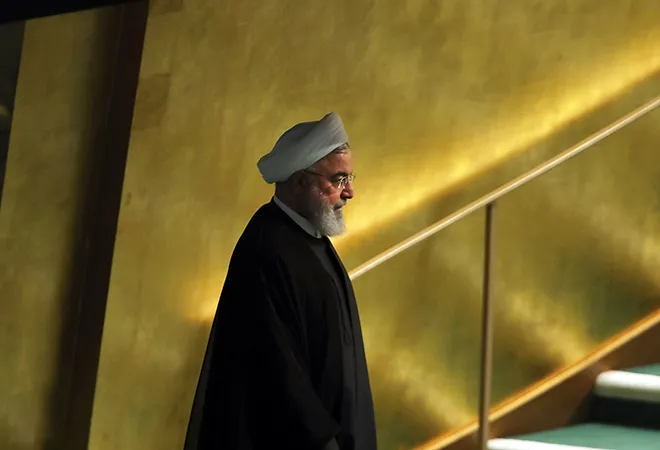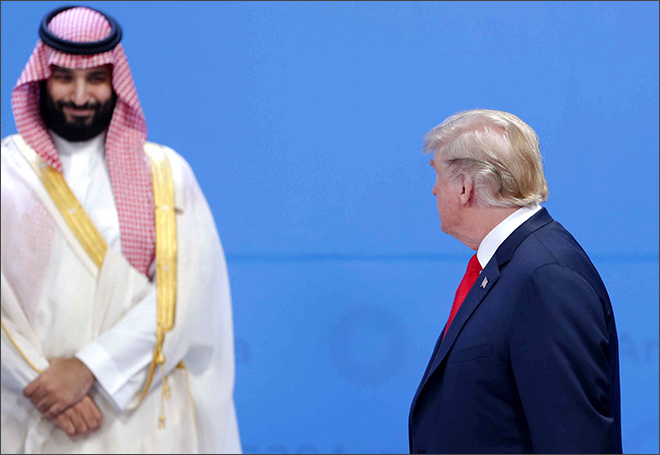-
CENTRES
Progammes & Centres
Location
The ensuing kerfuffle between the US, Iran and Saudi Arabia has displayed the different directions that both Riyadh and Washington have taken, despite months of bravado regarding regional transgressions, made by Iran in the region.

The 74th United Nations General Assembly (UNGA) held in New York expectedly became the diplomatic centrestage for the escalating conflict between Iran and Saudi Arabia. With the US continuing to push Tehran into a corner via sanctions over its nuclear programme and regional push to challenge Washington’s allies in Riyadh and Jerusalem alike, the situation has observed consistent escalations over the past few weeks.
Iran’s president Hassan Rouhani lamented the US as “supporter of terrorism” at the UNGA, with US President Donald Trump continuing to highlight Tehran as the main promoter of terrorism in the world. Initially, some reports had suggested that a Trump and Rouhani meeting could be in the offering. However, the Iranian president attached conditions of a full rollback of economic sanctions for such a dialogue to take place. Trump took to his preferred mode of communication — Twitter.
Earlier in September, an attack on Saudi Arabia’s oil facilities in Abqaiq pushed regional tensions into the deep red. As per reports, drones and possible missiles were used to significantly damage the massive oil field, which is responsible for around 5% of the world’s annual oil production. However, the attack raised much larger and existential questions for the Saudis on the defence front, as to how drones were able to penetrate its air defences and enter one of the most sensitive and highly protected facilities in the region. Saudi Arabia was the world’s largest importer of weapons in 2018, and purchased 22% of America’s arms exports between 2014 and 2018. This violation and attack on its main national security asset, oil, and the apparent ease with which it was conducted raised serious questions for the Kingdom within, on the gaps between procurement of weapons as a foreign policy strategy and actual defence preparedness.
Saudi’s reaction to the attacks on Abqaiq were oddly sombre, with no military retaliation and limited verbal pushback or threats.
Interestingly, Saudi’s reaction to the attacks on Abqaiq were oddly sombre, with no military retaliation and limited verbal pushback or threats. The US, which blamed Iran for the same, put the ball in Saudi’s court to back Washington’s claims; giving the Trump administration justification to target Iran militarily and forcing Saudi to recognise the Iranian strike overtly. None of these outcomes took place, in fact, the UAE, Saudi Arabia’s closest ally with its leader Crown Prince Mohammed bin Zayed al Nahyan was seen as one guiding Saudi heir apparent Mohammed bin Salman (MBS) through both his accession to the throne and his mandate to open up the Saudi economy and, in a controlled manner, its society. However, the never–ending civil war in Yemen, theatre to the indirect Iran–Saudi conflict being played out between the Iran–backed Houthi rebels and Saudi–led forces became an odd gravesite for the Saudi–UAE military bonhomie. In July, the UAE announced that it was to change its military strategy on the Yemen crisis, drawing down number of troops and military operations in exchange for a more diplomatic approach. A UAE official was quoted as saying the change in strategy was to move towards a “peace first” strategy.
 “MBS, who blames Iran for attacks on his oil fields, remains much less bullish on a military retaliation than his supporters in Washington DC.” Photo: Daniel Jayo/Getty Images
“MBS, who blames Iran for attacks on his oil fields, remains much less bullish on a military retaliation than his supporters in Washington DC.” Photo: Daniel Jayo/Getty Images
The UAE taking this step is also a mirror to what the Saudis should expect if they move towards building their own ‘global’ centres such as Dubai and Abu Dhabi, in an attempt to detach themselves from the addiction of petro–dollars. The UAE after its skirmish with Iran in the Gulf of Oman, with oil tankers in transit used as targets moved to de–escalate with Tehran further. A war in the region with Iran would automatically mean centres such as Dubai would become targets, potentially devastating UAE’s economic gains and stature as a centre of global trade, and perception as a stable, safe market to invest in.
More de–escalation took place around the concerns of the global oil markets. MBS, who blames Iran for attacks on his oil fields, remains much less bullish on a military retaliation than his supporters in Washington DC. In a rare interview recently, the crown prince said a military conflict could shoot oil prices up to “unimaginably high numbers,” leading to a collapse of the global economy, and not just the Middle East. Even though he backed American gusto against Tehran, calling the oil field attacks as an act of war, echoing US Secretary of State Mike Pompeo’s stance, the refusal of Saudis to opt for military action against Iran has put a ner in the Trump administration’s thinking. This ensuing kerfuffle between the US, Iran and Saudi Arabia has displayed the different directions that both Riyadh and Washington have taken, despite months of bravado regarding regional transgressions, made by Iran in the region, and portraying themselves as a union against Tehran.
While India has been forced to bring down oil imports from Iran to almost zero, Riyadh and UAE alike have remained consistent in announcing New Delhi as a major investment destination.
The threat of an over–heating oil price market and a threat war in the region also affects India as a net–importer of oil and having a large diaspora in the region. However, most oil consumers of Asia such as India, China, South Korea and Japan have remained largely mute, not wading into these regional tensions. This distance has mostly worked for these Asian economies, with New Delhi managing both its relationship with Iran and Saudi in equal measure. However, while India has been forced to bring down oil imports from Iran to almost zero, Riyadh and UAE alike have remained consistent in announcing New Delhi as a major investment destination. In midst of these events, New Delhi did find itself at interesting junctures of its bilateral diplomacy with the Middle East (West Asia). Foreign Secretary Vijay Gokhale visited Iran this month, while Minister of State for External Affairs V. Muraleedharan held talks with counterparts in Iraq and Kuwait. At the sidelines of the UNGA, Prime Minister Narendra Modi also met Iran’s President Hassan Rouhani.
Even during the much–celebrated meet between Modi and Trump after the Indian Prime Minister’s public event in Houston where the US president also made an appearance, the American leader consistently avoided to lament Pakistan as the main sponsor of terror in the world and instead repeatedly offered himself as a potential mediator. In fact, it is safe to say, Trump was looking towards India to give weight to his assertions on Iran in return for his administration’s support to tighten the noose around Islamabad.
The security situation in the region may witness a de–escalation, despite a major attack in Saudi Arabia. While this bodes well for regional geo-political and global economic stability, the use of drones and other ways of ‘indirect warfare’ is setting a new precedence of proxy wars between Riyadh and Tehran. Militias in Syria, interference in Iraq’s polity, the Yemen civil war, targeting of trade in the Persian Gulf are dangerous maneouvers that are consistently putting the region on the edge, and a major conflict may in fact have the likes of Riyadh and Abu Dhabi stand to lose much more than Tehran.
The views expressed above belong to the author(s). ORF research and analyses now available on Telegram! Click here to access our curated content — blogs, longforms and interviews.

Kabir Taneja is a Deputy Director and Fellow, Middle East, with the Strategic Studies programme. His research focuses on India’s relations with the Middle East ...
Read More +